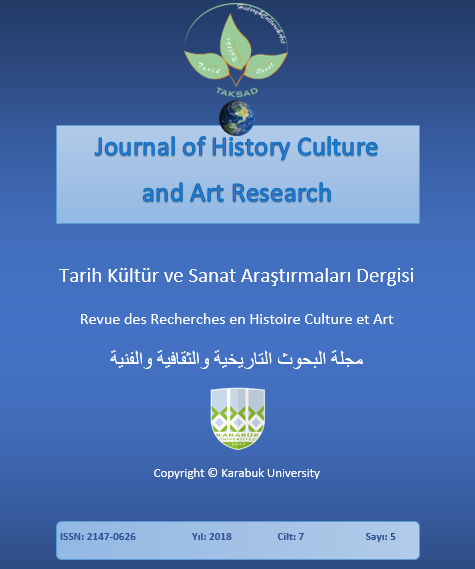A Comparative Study of Safavid Fabric Designs with Miniatures in School of Second Tabriz (With a focus on the Works of Sultan Mohammad, Mir-Musavvir and Mir-Sayyid Ali)
DOI:
https://doi.org/10.7596/taksad.v7i5.1782Keywords:
Weaving fabrics, Painting, Second tabriz school, Fabric designers, Fabric motifs.Abstract
Iranians experienced a golden age of textile art-industry during the Safavid period. In terms of beauty, design, colour and configuration, textiles of this period are influenced by the style of the painters who had a realistic tendency and paid attention to natural elements to represent thoroughly the external world in small logs. Early in Safavid era, the school of second Tabriz was established to mark a historic turning point in Iran’s painting. What we observe is a good cooperation between painters and weavers in designing fabric motifs that led to producing the most beautiful, irreplaceable and priceless fabrics, brocade, velvet and silk in the world. The purpose of this study is to examine the impact of three painters of Tabriz School (Sultan Mohammad, Mir-Musavvir and Mir Sayyid Ali) on the design of fabrics, and match the images and motifs designed by them. The main research questions are as follows: 1) what relationship exists between the designs of initial Safavid fabrics and Persian painting in second Tabriz School? 2) Were the fabric motifs in early Safavid designed by painters of second Tabriz School? This study examines the impact of Tabriz School painters on two areas of main and background fabric designs, which are divided into two groups of abstract and realistic. The results of matching fabric samples remained from the well-known painters of that era show textile designs by those painters, and it can be stated that artists like Sultan Muhammad, Mir-Musavvir and Mir-Sayyid Ali each followed a particular style in designing fabric motifs in second Tabriz School. This study was based on descriptive - analytical method and data collection was observational through library research.
References
Alessandri, V. D. (2006). Diaries of Venison in Iran (six diaries). In Amiri, M. (Trans.). Tehran: Khwarizmi.
Anavian, R. & Anavian, G. (2007). Royal Persian and Kashmir Brocades. Tehran: Iranian Academy of the Arts.
Azhand, Y. (2006). Tabriz painting school, Qazvin and Isfahan. Tehran: Iranian Academy of the Arts.
Baker, P. (2007). Islamic knits, In Shayestefar, M. (Trans.). Tehran: Institute of Islamic art studies.
Binyon, L.; Wilkinson, G. V. S. & Gary, B. (2005). Circulation of Iran’s miniature history. In Iran Manish, M. (Trans.). Tehran: Amir Kabir.
Della Valle P. (1998). Diary. In Shoaodin, Sh. (Trans.). Tehran: Scientific and Cultural Publication.
Forouzantabar, H. (2003). Safavid’s fabrics. Art and architecture magazine, 56, 104-115. Tehran.
Gary, B. (1976). View to miniatures in Iran. In Shirvanloo, F. (Trans.). Tehran: Tous.
Gholamrezaey, Z. (2008). Miniatures of Iran’s knits from era to Safavid era. Journal of Iranian Folklore Quarterly, 42-43, 9-28. Tehran: Research and Polling Center of IRIB.
Hakimian, B. (2006). Study form and design of Safavid era by miniatures School. Isfahan culture Magazine, 32, 86-99.
Hedayati, S. & Shayestefar, M. (2003). The effect of painters’ style of Safavid era on designing the fabrics of this era. Book of moon art magazine, 141, 56-69.
Jaffari Naemi, M. H. (2003). Designs and symbolic paints in Yazd knitting school of Safavid era. Book of art moon magazine, 141, 33-38. Tehran.
Modaressi, S. (2013). Studying the circulation of wear revolution paints in miniatures effects of Safavid era. Unpublished M.A. Dissertation, Shahed University. Tehran.
Pakbaz, R. (2009) Painting of Iran from era to today. Tehran: Zarin and Cimin.
Pope, A. U. & Ackerman, P. (2006). Circulation in Iran’s art (5 and 12). In Darya bandari, N. & others. (Trans.). Tehran: Scientific and Cultural Publication.
Rahnavard, Z. (2016). The history of Iran’s art in Islamic era: painting. Tehran: Samt.
Rouhfar, Z. (2008). View to Islamic knitting era. Tehran: Samt publications.
Scarchia, J. R. (1995). The history of Iran’s art (Safavid art, and, Qajar). In Azhand, R. (Trans.). Tehran: Molla.
Sherley, A. (1983). Diaries of Sherley ’brothers. In Evans, (Trans.). Tehran: Negah.
Tavernier, Z. B. (1982). Tavernier’s diary. In Nouri, A. (Trans.). Esfahan: Sanai.
Welch, Stuart Cary. (2010). Iran painting: prescription miniatures of Safavid era. Translation of Ahmad reza Tagha. Tehran: Matn.
Yavari, H. (2014). The history revolution of fabrics in Iran. Tehran: Simaye Danesh.
Downloads
Published
How to Cite
Issue
Section
License
All papers licensed under Creative Commons 4.0 CC-BY.- Share — copy and redistribute the material in any medium or format
- Adapt — remix, transform, and build upon the material for any purpose, even commercially.
Under the following terms:
Attribution — You must give appropriate credit, provide a link to the license, and indicate if changes were made. You may do so in any reasonable manner, but not in any way that suggests the licensor endorses you or your use.
- No additional restrictions — You may not apply legal terms or technological measures that legally restrict others from doing anything the license permits.







